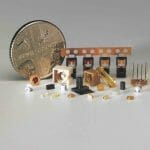~ Helping engineers choose the right gear unit for their application ~
Gearbox, motor and drive manufacturer, WEG has published an infographic to help engineers understand gear technology. The infographic, which provides an introduction on the five popular gear types and offers application-specific considerations, ensures plant operators have the information they need before purchasing a gear unit. It can be viewed on the WEG website.
Although they are responsible for gear selection, engineers and plant operators are often not experts in gear technology. That’s why WEG’s new infographic visually shows the considerations companies must make before purchasing a gear unit. Now engineers can understand different gear types and choose the right one for their application — without the long read.
Gears are among the most important components in a wide variety of drive trains. They transmit the right amounts of movement and force to ensure machines run smoothly.
What’s more, gears and geared motor developments are now at an extremely advanced stage. Improvements to materials, designs and efficiencies have largely been exhausted, which means it’s now more likely that new developments will be seen on the electronic side.
It is therefore essential for engineers to know how these machine components will integrate into their application, and the overall digital factory.
“Each gear type has its own configuration, features and benefits,” explained Marek Lukaszczyk, European & Middle East marketing manager at WEG. “While gear information is aplenty, this infographic provides a visual and accurate understanding of what to consider when purchasing a gear unit.”
WEG’s easy-to-understand infographic has examples of the varied types of gears and their classifications. It covers:
- Helical gear units
- Parallel shaft gear units
- Bevel gear units
- Worm gear units
- Planetary gear units
When selecting a gear type, engineers should know which loads and environmental factors the unit will be subjected to. Space requirements — such as drive output, drive control and other ambient conditions — must be considered, especially when retrofitting. After all, once a unit is installed, no additional design changes should be required to your existing machines or systems.
“The considerations of purchasing a geared motor go further than the motor itself,” added Lukaszczyk. “Design modifications, application conditions, spatial conditions of the application and the installation dimensions of a geared motor are also key factors. That’s why assessing where the unit is used helps prevent added costs, as the more defined the initial specification, the better.”
If you would like to contact WEG for further expert gear advice, or require information on WEG’s gearboxes, motors and drives, visit the company website here.








